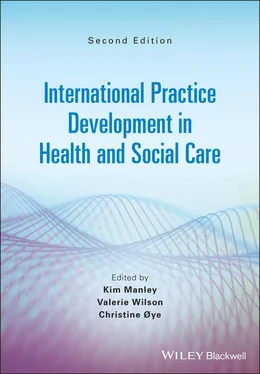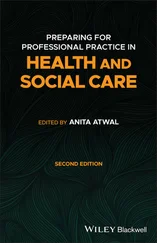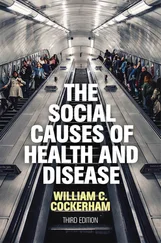1 Cover
2 Title Page International Practice Development in Health and Social Care Second Edition Edited by Kim Manley Valerie Wilson Christine Øye
3 Copyright Page
4 List of contributors
5 Foreword
6 Foreword
7 Acknowledgements
8 1. Transforming Health and Social Care Using Practice Development Setting the scene at this time of high challenge Practice development: its relevance to contemporary health and social care and crisis Practice development: growing scope and impact from interprofessional collaboration and working with shared values Developments since 2008 international edition Living our values as editors and authors The key concepts and structure of the book Conclusion References
9 2. Shaping Health Services Through True Collaboration Between Professional Providers and Service Users Introduction Examples of collaborative approaches Discussion Conclusion References
10 3. Turning Point: Curious Novice to Committed Advocate Inclusivity, relatability, effectiveness – Ciaran’s Eureka Building contextual readiness – Cathy’s nemesis and enlightenment Engagement Facilitation – Crystal’s unrecognised talent Co‐production – collective ownership Giselle’s experience with co‐production Conclusion References
11 4. Sustainable Person‐Centred Communities Design and Practice Introduction The litmus test – what are sustainable person‐centred communities? Facilitating creative and brave practitioners – critical appreciation of sustainable person‐centred communities’ design and practice Concluding remarks References
12 5. Promoting Person‐Centred Care for Older People Introduction Illustrating the application of claims, concerns and issues Case studies International, cross‐setting and interdisciplinary learning Conclusion and implications for undertaken practice development in aged care services References
13 6.Education Models Embedding PD Philosophy, Values and Impact – Using the Workplace as the Main Resource for Learning, Developing and Improving Introduction Case study 1: The value of integrating a person‐centred curriculum Case study 2: Place‐based learning Measuring the impact of CPD in the workplace Summary and conclusion References
14 7. Critical Ethnography: A Method for Improving Healthcare Cultures in Practice Development and Embedded Research Introduction Critical ethnographer as an embedded researcher Introducing two case studies Critical ethnography: a method for discovering ‘hidden’ practices and an avenue for practice development Conclusion References
15 8. A Global Manifesto for Practice Development: Revisiting Core Principles Introduction Revising the PD principles through a stakeholder review process Emergent themes Comparing the 2008 PD principles with the revised 2020 PD principles Conclusion References
16 9. Theorising Practice Development Introduction Theoretical origins Working with the ‘critical’ in critical reflection Connecting through crisis: critical social science and person‐centredness in PD research Theory in action: a bicultural perspective Reflecting on the future of theory and practice development Invited commentary – Dr Deborah Baldie References
17 10. Unpacking and Developing Facilitation Introduction Unpacking facilitation – an overview Facilitator development – developing person‐centred facilitators Facilitator development – moving to advanced facilitation Conclusion References
18 11. Re‐Imagining Participation in Processes of Facilitation: a Case for ‘Humble Assertiveness’ Introduction The process of facilitation – case examples The complexity of facilitation – achieving meaningful participation A commonality: culture A commonality: participation An approach towards facilitation: humble assertiveness References
19 12. Leadership Relationships Introduction Relational leadership Leadership development strategies that enable effective workplace cultures Conclusion References
20 13. From Fractured to Flourishing: Developing Clinical Leadership for Frontline Culture Change Introduction Background The case studies Discussion Conclusion References
21 14. Systems Leadership Enablement of Collaborative Healthcare Practices Introduction Developing systems leadership and management capability using facilitated learning Keeping people focused with increasingly complex healthcare systems Systems leadership and workforce factors influencing transformation The role of facilitative leadership in improving care for older people across the system Conclusion References Appendix 14.1 Appendix References
22 15. Recognising and Developing Effective Workplace Cultures Across Health and Social Care that are Also Good Places to Work What is workplace culture and why is it important? Background to collaborative inquiry Developing ‘guiding lights’ through collaborative inquiry Conclusion References
23 16. Wellbeing at Work Introduction What is wellbeing? Flourishing Why wellbeing matters at work Dissemination and sustainability Launching the Wellbeing Strategy Recognising the person and celebrating their achievements Knowing what matters Enhanced communication opportunities Access to education Living our values Key insights Conclusion References
24 17. Flourishing People, Families and Communities What is community flourishing? Facilitating community engagement and development using practice development principles Empowering citizens and communities to flourish through participatory research methods Conclusion References
25 18. Practice Development – Towards Co‐Creation, Innovation and Systems Transformation to Foster Person‐Centred Care Introduction Societal challenges for a new decade Practice development and person‐centred care Practice development and user involvement through co‐creation Practice development and innovation Practice development and system approaches PD: enabling through leadership and facilitation Practice development beyond methods and a new global manifesto for PD New directions through the International Practice Development Collaborative (IPDC) Q1 Who are the up‐and‐coming practice developers in your area? Q2 What professions (and consumers) do you currently engage in PD work? Q3 What areas of PD should we be focusing on in the coming years? Q4 What is one thing you would like to celebrate in relation to PD? Conclusion References
26 Index
27 End User License Agreement
1 Chapter 6Table 6.1 Place‐based learning across the East Kent PCNs – implementation and...Table 6.2 CPD transformation theories illustrating contexts (C), mechanisms (...
2 Chapter 8Table 8.1 Stakeholder critical review of PD principlesTable 8.2 Audit trail of the process for revising the original practice devel...
3 Chapter 14Table 14.1 NSW Health Leadership ProgrammeTable 14.2 Specific workforce enablers for transformationTable 14.3 System enablers that support systems leadershipTable 14.4 Intermediate and ultimate outcomes of systems leadershipTable 14.5 Key learning from facilitating this collaborative development proc...
4 Chapter 15Table 15.1 The four guiding lights for recognising and developing an effectiv...
5 Chapter 16Table 16.1 (C = core, E = elective)
6 Chapter 17Table 17.1 Seven elements of wellbeing (Coburn and Gormally 2015, p. 252)Table 17.2 KPI studies
1 Chapter 6Figure 6.1 Conceptual frameworkFigure 6.2 Co‐design process
2 Chapter 7Figure 7.1 Locating critical ethnography in the action cycleFigure 7.2 The ‘PD wheel’ – using PD as a starting point to drive research‐b...
3 Chapter 8Figure 8.1 Stakeholder critical review timelinesFigure 8.2 A stepped approach to engaging with PD principles – a global mani...
Читать дальше












